Battery Chargers
© Brooke Clarke 2005 - 2014
Background
Battery Life
Voltage & Current
Charger Types
DC Current
DC Voltage with Current Limit
Pulse Methods
Burp Charging
Charge Termination
Self Discharge
Trickle or Float
Smart Batteries
Rechargeable Chemistries
Lead Acid
Alkaline
Ni-Cad
Ni-MH
Li-Ion
Li-Poly
Chargers
Home Made
Commercial
Military
Patents
Links
Background
This web page is a direct result of
testing many battery chargers for use with the
5590BA Battery Adapter
that uses 20 or 22 AA cells and the need for a consolidated
approach.
Battery Life
A battery has some total Amp hour
life. For example if the battery is rated for 500 charge
discharge cycles and 2 Ah capacity then it's total life is 1000
Ah. This is related to both how it's charged and to how it's
discharged. If it's abused by discharging to deeply or by
over charging then the life is shortened.
The spec sheet has information on the minimum premissable
discharge voltage and recomended charging methods.
The problem with charging is the battery can have it's life
shortened by over charging. Severe over charging can kill
the battery just as severe discharging can kill some batteries.
If a discharged battery is put on a charger the problem is
straight forward and almost any of the charge termination (
see below) methods will work.
The problem is when a partially or fully charged battery is put on
the charger. For example if you use the C/10 for 16 hours
charge on a full battery at the end of the 16 hours the battery
will not have any more charge than it had at the start. It
will be warm to hot and it's life will have been shortened by one
charge and some electricity will have been wasted. If a full
battery is put on a fast charger that uses -dV/dt charge
termination and the charger ignores -dV/dt for the first few
minutes to eliminate false stops on batteries that have not been
used for some time it may never terminate the charge. In
this case if there is no thermal limit charge termination the
battery will be killed by excessive temperature.
Voltage & Current
When a battery in good condition is connected to a charger the
terminal voltage will start out below the fully charged voltage
and move up to the fully charged value. But when a battery
that is discharged is connected to a charger it's terminal
voltage will be much higher than the fully charged voltage
because of high internal resistance and will move down in
voltage. In extreame cases it may be necessary to increase
the open circuit voltage a lot in order to get the battery to
draw charge current. When this happens it may be that the
battery is beyond recovery.
Charger Types
DC Current
The most common charger is just a DC current source. Most
any battery can be charged by feeding it a current that's it's
specified discharge Capacity divided by 10 (C/10). For
example a Ni-MH AA cell may be rated at 2.3 Amp Hours so it's C/10
charge current would be 230 ma. If the world was perfect you
would only need to put this current into the battery for 10 hours
and you would have put in 2.3 Amp Hours, but the battery and the
charging circuit have resistance that converts power into
heat. Also the battery may generate heat as part of the
chemical reaction related to charging, like a Ni-MH that nearing
full charge which also waste power. So instead of 10 hours
is common to see 12 to 16 hours for a slow charge.
For rates between C/10 and 1 C it may be possible to charge a
little faster, but it's not a good idea because you might be
getting into the area where the battery is going to have a
problem. This type of charger typically adds a timer to
control the amount of charge that's put into the battery.
Another way to prevent overheating to to monitor the battery
temperature. For example the charger for the Ni-Cad BB-590
battery does not check the battery chemistry because when a sealed
Ni-Cad is charging the chemical reaction causes a temperature rise
that's not present with Ni-Cad batteries.
If DC current is used in an attempt to fast charge a battery, say
at a rates way above C/10 the battery will not charge and might
vent, explode, catch fire or some combination of these. NOT
a good idea.
DC Voltage with a Current Limit
This is a common way to charge a Lead Acid battery. When the
battery is near dead it will draw current at the limit and as it
charges the terminal voltage goes up and so the current
decreases. At full charge only a trickle of current is
flowing into the battery. One problem is that the value of
the voltage depends on the battery temperature.
Pulse Methods
There are a number of methods where the charging current or
voltage is applied as a pulse or as pulses of different
amplitudes. By measuring the voltage with no load or with
one or more different loads some idea of the battery State Of
Charge (SOC) can be determined and this can be used to terminate
the fast charge and switch to a trickle to topping charge.
Burp Charging
A Burp Charger uses high current pulses for charging (maybe 10 C)
and also has high current (maybe 10 C) pulses discharging the
battery intermixed with the charging pulses. In order to
work the energy in the discharge pulses needs to be much much less
than the energy in the charging pulses. Wilford Burkett has
a number of patents on this method. As is common with
patented ideas they don't show up in reference text
books. For example the 2"+ thick "Handbook of
Batteries" Third Edition, ISBN 0-07-135978-8 has no mention of
Burp or Pulse charging methods, yet the patent office has a large
number of patents on these topics.
My experience comparing the
Maha C777+
charger that uses a pulse method to measure the battery condition
compared to the
Propel model BB-590
that uses the Galaxy 1702 smart Burp Charging controller chips
indicates that burp charging is a much better way to go. It
does a fast charge while only warming the battery, whereas the
C777+ gets the batteries very hot, and if the external temperature
sensor is not in good contact with a battery being charged there
is a good possibility of damaging a battery by overheating it.
6 Dec 2007 - I think a Burp Trickle charger could be made that
would maintain Ni-MH or Ni-Cad battery packs, i.e. put back the
power that would otherwise be lost to self discharge. If
this is of interest
let me know.
Note: Using a trickle charger on either of these chemistries will
overhead and quickly use up the life of the battery.
See the
Patents section below for more on Burp
Charging.
Charge
Termination
The standard method of charging a
battery when it's known to be discharged is to charge at C/10 for
16 hours. The
Maha C9000 has a
break-in mode (aka IEC capacity analysis) that: (1) 16 hr charge @
C/10, (2) rest 1 hour, (3) discharge at C/5, (4) rest 1 hour, 16
hr charge @ C/10. This is recommended for new batteries
(which have been sitting for many months and so are close to fully
discharged) or batteries that are known to be discharged. It
gives the battery a full capacity charge discharge cycle.
Note that a battery that was 100% efficient on the charge cycle
would only need 10 hours at C/10 rate to charge. At 16 hours
an extra 60% of it's capacity is being fed to the battery.
C/10 and Time
When slow charging (C/10 is considered a slow charge) the battery
will not overheat and so there's no time limit. For most
batteries 16 hours is enough to be sure you have fully charged the
battery. The
PP-7286/U uses
this method. There is a potential problem with this method
when the ambient temperature is hot in that a battery with a
partial to full charge at the start might over heat.
-dV/dT
As a Ni-Cad battery nears end of charge the voltage rises faster
that it did for most of the charge then peaks (the slope is zero)
then falls off with increasing negative slope. By looking
for the negative slope the charge can be terminated very close to
the 100% of charge point. This does not work for a C/10
charge but needs some higher rate.
A similar effect is present on Ni-MH cells but the size of the
peak is much smaller. So a charger made for Ni-Cads that
uses -dV/dt termination will not properly detect end of charge on
a Ni-MH cell.
As of Dec 2007 both Sanyo and Duracell (the only ones I've checked
recently) do not recommend -dV/dt as a charge termination method
for Ni-MH.
Zero Slope
Similar to the -dV/dt method above but instead of looking for the
negative slope it terminates at the peak.
Orthogonal Measurements
When making a measurement it's good to have Orthogonal
parameters. For example when measuring the
capacity of a battery the cell voltage is used to
determine the end of discharge. A plot of battery
cell voltage will have a steep slope (be nearly at right
angles to the time axis).
But if zero slope is used the slope of the curve is
parallel to the time axis so it's very difficult to say
when it's exactly zero.
|
This method can have problems with false termination due to
noise or temperature changes and so is not recommended.
Temperature
This is an absolute max temperature charge termination. When
a Ni-MH cell receives over charge at rates above C/10 it will get
very hot so a temperature sensor can be used to terminate the
charging. Tends to over charge when it's cold and under
charge when it hot. This is not recommended as a normal
charge termination method, but is recommended as a safety backup
termination method. The reason is that when any battery gets
very hot the life is shortened. For some applications where
battery life is not a concern like racing there is an advantage is
getting the battery hot because it produces more power.
dTemp
In delta Temperature the change in temperate is sensed. This
has an advantage in that the ambient temperature has less
impact. If absolute temperature is used and it's very hot
then the charging may be terminated too soon. In delta Temp
the battery starts out at the ambient temperature and charge is
stopped when the battery temp increases some specified
amount. This can work for fast charges where the charge time
is fairly short, but has problems it the charge time is many hours
because the ambient temperature changes during the night and day.
Duracell recommends this method when the parameters are matched to
the specific battery. For their "D" cell Ni-MH charged at 1C
terminate at delta T of 15 deg C (27F). No topping charge
needed. And use a 60C (140F) safety termination.
dTemp/dt
This is an improvement on the dTemp method since it's looking at
the slope and so will not be as influenced by the daily
temperature ambient temperature changes. Duracell has a plot
of battery capacity vs. the number of charges (1 to pver 300)
comparing -dV/dt to dTemp/dt. For the first 250 charge
cycles the -dV/dt method provides about 5% more capacity but after
250 cycles dTemp/dt provides more capacity and the -dV/dt capacity
starts falling off rapidly and the battery is dead by cycle
350 but the dTemp/dt battery goes to about 430 cycles.
Duracell recommends this method with a 1C charge rate and
termination at 1 deg C/min (1.8 deg F/min) with a 60 deg C
temperate backup. To make up for the 5% lower capacity this
method prvides they also recommend a top off charge of C/10 for a
half hour (that equals C/20 or 5%).
Pressure
When a battery is charged not only does the temperature increase
but also the pressure inside increases. There are no
commercial chargers that I know of using the pressure
increase. Probably because it's not easy to measure.
Impedance
TI used a combination of battery voltage, Coulomb counting and
cell impedance to determine state of charge. This has
implications for both discharge SOC indication and charging.
Others
There are a large number of other patented methods of charge
termination. The
burp methods for
example. Or the battery temp - ambient temp method.
Self Discharge
When any primary or secondary
battery is sitting on a shelf with no load attached it will
discharge. For the common Ni-Cad or Ni-MH chemistries this
may amount to one or more percent per day. For some data see
my
Ready to
Use Battery (low self discharge) web page.
In addition to discharging the battery also looses the ability to
be charged. This is a temporary effect, but all the chargers
I've seen don't know how to handle it. If you see that the
capacity of a battery is much lower than expected it's good to put
in on a few cycles of discharge and charge and note how the
capacity is changing cycle to cycle. If it does not improve
the battery is dead. But if it does improve keep cycling
until it flattens out.
Trickle or Float
A lead acid battery can have a
constant voltage applied that's near the fully charged battery
voltage and typically can only supply small currents. If the
cell voltage decreases due to self discharge then current flows
and keeps the battery fully charged. This is very good for
backup batteries and for maintaining a battery in a parked car.
Ni-Cad and Ni-MH batteries have a self discharge rate of about
C/300 to C/500 (that's 0.3 to 0.2 %/hour). But these
chemistries do not accept a DC charge at this low a rate according
to Sanyo. Duracell does recommend a C/300 trickle charge to
maintain it's Ni-MH cells.
Note if the hourly self discharge rate is C/400 that's 0.0025C per
hour. Since the discharge depends on the current capacity it
decreases and the capacity decreases. To get the daily rate
use (1-C/400)^24 so for C/400 the capacity after 24 hours is 0.94
or the battery has lost 5.8% of it's capacity. This is an
exponential type discharge not linear. Also it's very
temperature dependent, the hotter the faster the self discharge.
The self discharge is improved when a battery is stored in a cold
location. But the capacity of a battery like Ni-MH or Ni-Cad
decreases at cold temperatures and decreases rapidly for
temperatures near water freezing.
Smart Batteries
Li-Ion and Li-polymer batteries have
a venting & catching fire type problem if their terminal
voltage gets above or below specified limits or if the current
exceeds a specified limit (either charge or discharge). To
prevent this each cell has a safety circuit and the pack has a
current monitor. If any of the prohibited conditions exist a
FET switch opens the terminals. These protection circuits
are digital in nature and can be connected to a smart chip that
can communicate using a one wire serial protocol with the host
load or charger. The chips also have coulomb counting and
can predict the battery discharge time (gas gauge).
Some of these use stock chips and public data protocols and can be
used in other applications. Others use a micro controller
with a proprietary interface protocol and can not be used by
anyone else. So that great eBay deal for a laptop battery
that's for a computer you don't have may be next to useless as far
as the gas gauge is concerned.
2016 update - Some of the modern BB-2590 batteries now have SMBus
(
Wiki)
connections. This is identical to the bus used between a
laptop and it's internal battery. There are a dozen or more
standard parameters and a huge number of proprietary parameters
possible. TI has hardware (
TI: EV200) to talk to
their battery management chips and allow setting the parameters to
match the actual battery. They intend that the parameters
will all be the same for a given production run or even design,
but could be used to customize the parameters for a specific
serial number battery. When the parameters are set loosely
they are typically set to be conservative and so effectively
decrease the battery capacity by under charging and stopping
discharge too soon. So an accurate setting of the parameters
allows both putting in more charge and discharging to near the
lower capacity limit thus increasing the effective battery
capacity.
6832171
Circuit and
method for determining battery impedance increase with
aging, TI, Dec 14, 2004,
702/65, 320/132 - impedance & SMBus
7443140
Method and apparatus for
operating a battery to avoid damage and maximize use of battery
capacity by terminating battery discharge, TI, Oct 28,
2008,
320/136,
320/135,
324/427
- bat imp used to correct terminal voltage to get to actual
battery voltage.
Rechargeable Chemistries
A primary battery has a chemistry
that only goes in one direction (discharge). If you try and
put charge into this type of battery it's not going to charge and
may very well do something nasty. A lot of thought and
effort goes into preventing attempts at charging primary
batteries. For example an early
BA-5800
(all military batteries with a name starting BA- are primary
types) used in a PLGR that was designed to charge a battery when
the
PLGR was connected to a vehicle
tended to explode the primary battery. The sockets on the
BA-5590 family of batteries are divided into two types primary
with 5 keying slots and secondary with 4 slots to mechanically
prevent a properly designed charging device from connecting to a
primary battery. The
BA-5590
primary battery has no connection to pin 3, but all the secondary
batteries in the family connect negative pin 1 to pin 3.
This way if a charger uses pin 3 instead of pin 1 it can not
charge a primary battery.
Lead Acid
This is one of the oldest types of
rechargeable battery and comes in a number of different
forms. I'm not going to spend much time on them except to
say that you need to keep them away from electronics. I
got a very good deal on a Gibbs precision oscillator because it
was designed with the gel cell batteries in the same box as the
electronics. When during normal charging the batteries
vented with a track of sulfuric acid over time the traces were
etched from the PCBs in the warmer parts of the package.
Typically charged with constant voltage and current limit.
The Cyclon cylindrical Lead Acid deserves special mention.
I learned about this battery when working with a military
O-1814 Rubidium Frequency and Time
standard that uses them for a back up battery. Virtually
all the other batteries I've looked at prohibit discharging to
zero volts. For example if you discharge a car battery to
zero volts it's dead and will no longer take a charge.
BUT, the Cyclon can be discharged to zero with the proviso that
it will be charged within a reasonable short time, like what
would happen when there's a power failure.
When other types of batteries are used in backup systems the
controller needs to have a way of disconnecting the battery when
the cell voltage gets to the minimal allowed to prevent pulling
the cell to zero volts. Note for rechargeable batteries
the nominal voltage ( 12 V for a car battery) is the minimum
voltage for discharge.
It turns out that the designers of the O-1814 should have also
done that, since it was used in a vehicle mounted system , not
an line powered system where the battery would automatically get
charged. In the vehicle system if a soldier turns of the
power to the whole system at the central power panel then the
O-1814 backup battery runs to zero volts and does not get
charged until the next time the system is used which may be many
months. This resulted in a lot of problems since the
backup battery is inside the unit and soldiers are not
authorized to open the unit and replace the batteries. In
general the military no longer buys anything that has an
internal battery since it will no longer function when that
battery dies.
Alkaline
The Alkaline chemistry goes way
back to the
Leclanché Battery
which could be recharged by changing the electrolyte. The
more modern Alkaline battery has a chemistry that can go both
ways, but has not been optimized to do it efficiently.
Rayovac does make a rechargeable Alkaline battery but it has
limited charge cycles when compared to other rechargeable cells.
For many years Alkaline batteries used a small amount of Mercury
to prevent the zinc from oxidizing. When Mercury was
removed from Alkaline batteries there was a lot of development
work (and many many patents) on ways to replace it. If you
look at a package of Energizer or Wal-Mart Alkaline batteries
you will see a couple dozen patent numbers, and almost all of
them are related to ways of getting around the Mercury
problem. But a couple of them are related to getting more
energy out of the battery, see:
6022639
Zinc anode for an electochemical cell Feb 8, 2000 429/229 (15.6
amp short ckt curr ? batt size)
6589693
High discharge electrolytic manganese dioxide and an electrode
and alkaline cell incorporating the same July 8, 2003
429/224; 429/218.1; 429/229; 429/231.8
These patents are aimed at providing high discharge currents and
are a big improvement over conventional Alkaline cells.
For more see my 5590BA web page on
internal
resistance and load testing.
Ni-Cad
This was the rechargeable battery
that enabled a very large number of battery powered devices like
drills, tooth brushes, electric shavers, hand held radios, etc.
that needed a battery that could supply high currents and was
small and light weight. There was a "memory" problem with
early Ni-Cads, but it's not clear to me if this is still true of
modern Ni-Cads. Know for their good performance under
heavy discharge and heavy charge. A workhorse
battery. These do not overheat like Ni-Cad cells when
fully charged and so are easier to charge (not temperature
sensor needed).
Typically charged using a constant current. If above C/10
then a charge termination methods is needed such as a timer,
terminal voltage, it's slope vs. time, or some pulse method is
used.
Ni-MH
These provide more Amp Hours than
a Ni-Cad of the same size. They may not have the Ni-Cad
memory problem by may have a decrease in capacity after some
amount of use. This effect may also be caused by improper
charging (i.e. overheating during charge). For example a
battery that should have a run time of 6.9 hours only has a run
time of 4.2 hours after a single over charge incident.
These batteries get very hot when fast charged and they are near
full (maybe at 80% of capacity). If an over temperature
method is used to terminate charge either some capacity is
sacrificed or there is a danger of damaging the battery by over
heating.
The peak voltage and voltage slope methods that work for a
Ni-Cad will not work for a Ni-MH unless they are much improved
versions since the voltage increase with the Ni-MH is smaller
and harder to detect. A charger that can charge a Ni-MH
will typically also work with a Ni-Cad, but not the other way
around.
I've heard that there is a patent licensing limit of 10 Amp
Hours (a "D" cell) and that's why a Prius battery is a bunch of
"D" cells and not a larger battery.
Li-Ion
These cylindrical cells offer the
highest Watt Hour capacity for the volume they occupy.
This is the current standard battery for laptop computers, cell
phones and other high tech products.
They require protection circuits and specialized chargers.
Li-Poly
These pouch cells offer the
highest Watt Hour capacity for the weight and are popular with
RC model airplane hobbyists. They have the same need for
protection circuits and special chargers as the Li-Ion batteries
although the RC airplane folks typically remove the protection
so that they will not crash the plane due to a low battery, but
they may burn up the family car as a result.
Chargers
Commercial
Single Cell Chargers - there are a
huge number of these some cheap DC type and maybe others are
Burp types.
Rayovac
3in1
- 4 station "D" cell or smaller - will charge their rechargeable
Alkaline as well as Ni-Cad and Ni-MH
Honda
Optimate 3+ Desulfating Battery Charger, Maintainer,
Tester
Maha H-C777Plus - single station
combined charger discharger with LCD readout of mAH put in to
removed, uses mag mount thermoter. No information on how
it works, but appears to be a DC type with pulse for state of
charge measurement. Gets Ni-MH cells very hot on every
charge.
Lab Type Power Supply - can be used for charging all kinds of
batteries and will bring back from dead batteries that the Maha
will not.
Battery Space
Universal Smart
Charger -
Maha MH-C401FS - AAA/AA smart
charger - supposed to do a good job on Ni-MH cells. Got it
for Sanyo
Ready To Use (long shelf
life) cells
Maha
MH-C9000 - this is a charger
analyzer for AA or AAA cells, but I don't see why it could not
also work with C or D cells, i.e. any single cell rechargable
battery that was Ni-Cad or Ni-MH.
Triton2 Charger Discharger Cycler
Samya AQ-K800i Cell Phone External Battery Charger
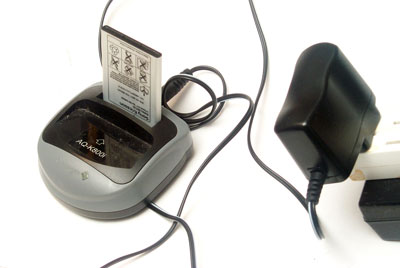 |
The modern energy saving Switch Mode
Power Supply is rated for inputs of 100 to 240 VAC 50/60
Hz (i.e. it's a worldwide wall wart) with an output of 6
VDC @ <= 400 ma.
Works best when two batteries are used, one in the cell
phone and one that's being charged ready to be swapped.
|
Radio Shack 23-335
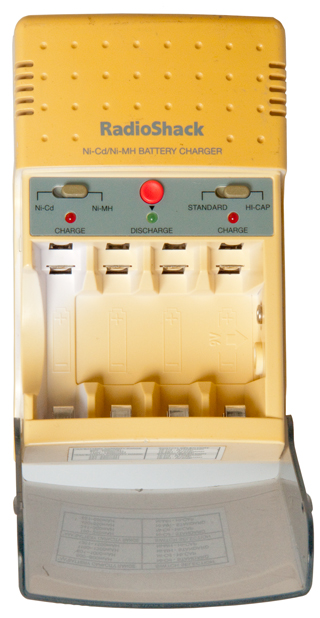
|
This charger has a clear plastic cover. The first
generation Maha MH-C401FS
also came with a clear plastic cover, but
they said to remove it and didn't ship later units with
the cover because it can overheat the batteries while
they are charging.
This Radio Shack unit can both discharge and charge AA,
AAA or 9V batteries, either Ni-Cad or Ni-MH. It
gets within 100 mAh of the MH-C401FS on a 2600 mAh AA
cell.
Switches for selecting battery chemistry and Standard or
Hi Capacity and a button to discharge.
The table on the bottom has AA and AAA battery capacity
ranges for the various switch combinations but not for
9V batteries.
|
Harbor Freight Item 42292 Battery Float
Charger (Manual: 42292.pdf)
Very similar to the Cen-tech
SKU: 59000.
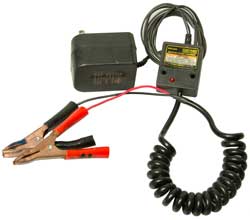
|
|
Schumacher SE-1-12S Battery Charger &
Maintainer
(Manual: 00-00-000457.pdf)
1.5 Amp, 12 Volt
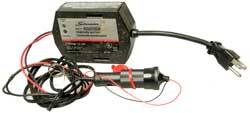
|
20050088144
System and method for charging batteries, David
Pacholok, Thomas Johnson, Xiao Chen, Schumacher Electric
Corp, 2009-05-05, -
cites
230 patents; cited
by 91 patents;
|
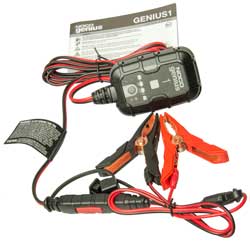 |
See my Generators web page.
|
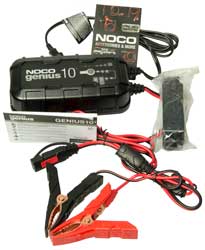 |
See my Vehicles web page
|
Military
When I started this web page (2005) there were a very limited
number of BA-5590 family batteries, now (2016) there are many.
It turns out that the charger needs to be matched to the
battery chemistry. So am adding a table relating these.
Maybe the charger needs to be the same brand as the battery?
Charger
|
Chemistries
|
Batteries
|
Special
|
| PP-6224 |
Lead
Acid
|
|
na
|
WKW-7
|
|
na
|
706841-801
PP-7601
|
Ni-Cad |
BB-588/U
BB-715/U
548103-804
6140-01-241-2295 |
na
|
| PP-7286/U |
BB-505,
BB-507,
BB-516,
BB-557,
BB-590,
BB-655,
BB-699/PAQ-1,
BB-704 and
MC-1605 |
na
|
| Propel BB-590 |
BB-590 |
na
|
TMQ-37
|
BB-557 |
na
|
PP-8444A/U
SPC
|
Ni-MH
|
BB-390
|
Thermistor
contacts
|
PP-8498/U
SPC
|
Ni-MH
Li-Ion
|
BB-390A/B
BB-2590/U
BB-388/A
BB-516A/U
BB-503A/U
BB-2847/A
BB-557/U
BB-2600/A
BB-2800/U
|
PP-8481/U VMC/COTM
|
BB-390A/B
BB-2800/BB-390/BB-2590/BB-2847/C-Sel
BB-390/2590/516A/326/388/2588/2847/MBITR/2800
BB-2600/557/2557
Falcon/BB-2800/390/2590/2847
Motorola IISR
Ni-Mh&Ni-Cad AA
USLW Li-145/Li-80
Eagle
6 station Soldier Intercom
|
BTC-70879-1 VMC
Lite
|
VMC-390/2590:
BB-3990/2590
C-SEL/BB-2800/390/2590/2847
MBITR/BB-2800/390/2590/2847
Universal: BB-390/2590/516A/326/388/2588/2847/MBITR/2800
BB-2600/557/2557
Falcon/BB-2800/390/2590/2847
Motorola IISR
Ni-Mh&Ni-Cad AA
USLW Li-145/Li-80
Eagle
SPR/Falcon/BB-390/2590
Falcon
MBITR
Refleman
|
MRC-82A
|
Internal BB-2590
|
na
|
Ultralife
CH0002
|
Li-Ion |
BB-2590 family
|
na
|
MRC-85A
Ultralife CH0004
|
Ni-Cad
Ni-MH
Li-Ion
|
|
na
|
MRC-86
Ultralife CH0003
|
Ni-Cad
Ni-MH
Li-Ion |
|
na
|
706841-801
- 5 Station Magnavox for PRC-68 type Ni-Cad batteries with
internal thermistors DC fast & trickle
PP-6224 Power Supply is
designed to charge mil vehicle batteries or power radios also
see the
Harris
RF-5051-PS001 that has more capability and much lower size
and weight
PP-7286/U
- 5 station for a variety of Ni-Cads uses digital circuitry and
regulated current for specified time then shutoff
PP-7601
- 6 station for PRC-68 type batteries digital circuitry, not
manual or info.
PP-8444A/U
- 2 or 4 station suitcase universal charger different versions
can charge different chemistries (not for BB-2590)
PP-8498/U - Soldier Portable Charger
(SPC) - suitcase AC or DC input
Patents
Class
320 Electricity: Battery or Capacitor Charging or
Discharging
127 Battery or Cell Discharging
128 With charging
129
Pulsed discharge (Burp)
137 Battery or Cell Charging
139
Pulsed
152 Detection of current or voltage amplitude
155 Time control
156 Detection of current or voltage differential (e.g.,
slope, etc.)
160 Multi-rate charging (e.g., plural charge rates before
a maintenance charge, etc.)
Burp Charge
There are those on the internet that think Burp Charge is snake
oil and does not work. Burp Charging does NOT cause the
cells to get hot. The Maha C777+ charger stops charging
Ni-MH cells based on an over temperature error (140 F). Burp
Charge is a pulsed discharge during the charging process.
Wilford Burkett's Burp Charge Patents
3517293
Rapid Charging of Batteries June 23, 1970
320/129;
320/152
3559025
Rapid Charging of Batteries Jan 26, 1971
320/129;
320/153
3597673
Rapid Charging of Batteries Aug 3, 1971
320/129;
320/153
3609502
High Frequency Battery Charger Employing an Inverter Sep 28,
1971
320/129;
320/139; 320/158; 320/DIG17 - includes Burp
3609503
Termination of Rapid Charging of Batteries Sep 28, 1971
320/129;
320/152; 320/DIG17 - Termination for a Burp charger
3614582
Rapid Charging of Batteries Oct 19, 1971
320/129;
320/139; 320/149; 320/DIG17
3614583
Rapid Charging of Batteries Oct 19, 1971
320/129;
320/139; 320/152; 320/DIG17
3626270
Battery Charger for Single Cells Dec 7, 1971 - also Burp
4413221 Method and circuit for determining battery capacity, Fred
Benjamin, Robert H. Heil (Christie Electric Corp), Nov 1,
1983, 320/48; 320/14; 324/427; 324/435
Uses discharge pulses during
charging. analog circuitry
4746852 Controller for battery charger, Ray J. Martin
(Christie Electric Corp), May 24, 1988, 320/20; 320/14; 320/21;
320/31; 320/39
uses the time deritive to
determine when charged
References:
|
| 3597673 |
RAPID
CHARGING OF BATTERIES |
Wilford Burkett
|
Aug 1971 |
| 4006396 |
Universal
battery charging apparatus <>Burp
|
Motorola
|
Feb 1, 1977 |
| 4134056 |
Apparatus
for charging rechargeable battery <>Burp |
Sanyo |
Jan 9, 1979 |
| 4213081 |
Method
and apparatus for charging sealed Ni-Cad
batt <>Burp Peak detection (Vnow <
Vmax)
|
no company
|
Jul 15, 1980 |
| 4354148 |
Apparatus
for charging rechargeable battery <>Burp |
Sanyo |
Oct 12, 1982 |
| 4385269 |
Battery
charger BURP
|
Redifon |
May 24, 1983 |
| 4388582 |
Apparatus
and method for charging batteries
<>Burp delta
|
Black & Decker |
Jun 14, 1983 |
| 4503378 |
Charging
system for nickel-zinc batteries <>Burp
inflection
|
GM
|
Mar 5, 1985 |
| 4639655 |
Method
and apparatus for battery charging
<>Burp |
|
Jan 27, 1987 |
Rapid battery charger, discharger and conditioner May 9,
1989
320/129
- More modern Burp charger
6459243 Multiple plateau battery charging method and system
to fully charge the first plateau Oct 1, 2002 320/155;
320/160 - has an overview of other types of charger patents.
3258671
Method for Increasing the Capacity of Silver Electrodes
(Silver-Cadmium, Silver-Zinc) -U.S. Navy Jun 28, 1966 320/139
4499415
Battery rapid charging circuit Feb 12, 1985
320/139
; 320/163
Links
Back to Brooke's Products
for
Sale, Batteries,
Rechargeable Battery Summary For
Kosovo Deployment -
Battery
spreadsheet
with cross links replacements and chargers -
Back to Brooke's PRC68, Contact, Alphabetical
web page list, Battery Testers,
Products for Sale, Batteries, Military
Information, Personal Home
page created April. 2005.





